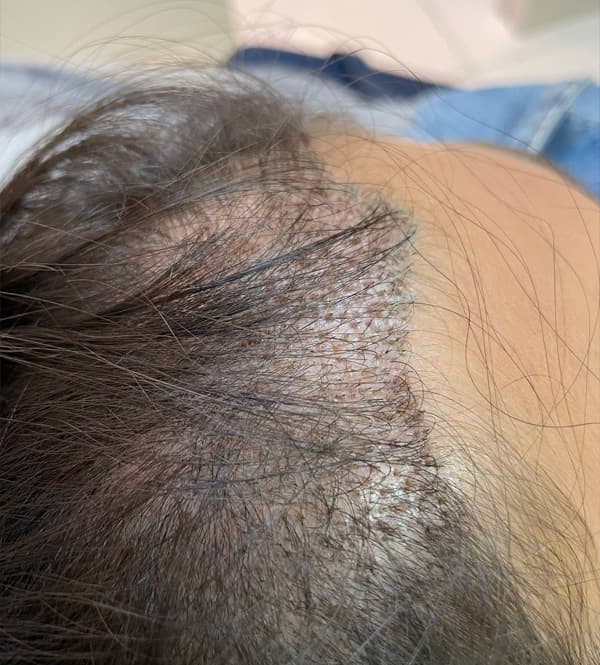Hair Transplant/Eyebrow Transplant

WHAT IS IT?
it is the process of removing hair follicles from a donor area, typically the back or sides of the patient’s head, which are not affected by genetic or hormonal influences, and implanting them into the balding area. There are various techniques for hair transplantation, such as Follicular Unit Extraction (FUE) and Follicular Unit Transplantation (FUT), for follicle extraction, and different methods of implanting the hair follicles.
For whom is it indicated?
Hair transplantation, also commonly known as hair implant or hair restoration, is indicated for women in cases of severe androgenetic alopecia (female pattern baldness) or in cases of scalp diseases that have stabilized and have been treated for some time without complete resolution.
It is also recommended for cases of burns or hair loss due to traction.
Women who experience the following symptoms should consider a consultation for hair evaluation:
Some women who do not suffer from hair loss or baldness but are concerned about the size of their forehead have increasingly sought a solution through hair transplantation.
It is also recommended for cases of burns or hair loss due to traction.
Women who experience the following symptoms should consider a consultation for hair evaluation:
- Thinning hairline
- Sparse hair at the front of the scalp
- Bald patches on the top of the head
Some women who do not suffer from hair loss or baldness but are concerned about the size of their forehead have increasingly sought a solution through hair transplantation.
How is the surgery performed?
The FUE technique, preferred by Dr. Túlio Martins in the majority of cases, is a surgery that involves extracting hair follicles from a donor area of the patient and transplanting them to an area with hair loss, implanting them one by one while preserving the roots. The donor area for this technique needs to be shaved, but the recipient area does not, allowing the long hair to cover the shaved area and giving a natural appearance, making it difficult to identify that the procedure was done.
In the FUE method, hair follicles are directly extracted from the donor zone through multiple small incisions. After extraction, the surgeon makes small cuts with a blade or needle in the recipient area of the scalp, where the healthy follicles are placed.
In the FUT technique, which is commonly used in women, a strip of scalp from the back of the head is removed, and the sutures are made in that area. This strip of hair is then dissected under a microscope, separating the follicular units, which are later implanted using the same technique as before. In this method, we don’t need to shave the back of the head, only the area where the strip will be taken from, but we have the inconvenience of sutures in that region and later removal of stitches. The scar is not a problem in this case because it is always hidden by long hair.
The transplant can be performed in multiple sessions if necessary, in order to fill in the majority of the bald areas on the scalp.
Transplants can also be performed on eyebrows, using the same techniques as described before.
In the FUE method, hair follicles are directly extracted from the donor zone through multiple small incisions. After extraction, the surgeon makes small cuts with a blade or needle in the recipient area of the scalp, where the healthy follicles are placed.
In the FUT technique, which is commonly used in women, a strip of scalp from the back of the head is removed, and the sutures are made in that area. This strip of hair is then dissected under a microscope, separating the follicular units, which are later implanted using the same technique as before. In this method, we don’t need to shave the back of the head, only the area where the strip will be taken from, but we have the inconvenience of sutures in that region and later removal of stitches. The scar is not a problem in this case because it is always hidden by long hair.
The transplant can be performed in multiple sessions if necessary, in order to fill in the majority of the bald areas on the scalp.
Transplants can also be performed on eyebrows, using the same techniques as described before.
Benefits of the procedure
The results are extremely satisfying as it restores woman’s self-esteem, which is often closely tied to the appearance and volume of their hair, giving a healthier and more natural look. The healing process typically takes up to two weeks. However, on the same day of the surgery, the patient can go home, and the following day, they can resume their daily activities with the necessary precautions as advised.
In general, a noticeable difference can be observed about six months after the surgery. However, the final results are typically seen after one year due to the hair growth cycles.
Hair transplantation is a safe option with long-lasting results. It leaves minimal scarring and requires a short recovery period.
In general, a noticeable difference can be observed about six months after the surgery. However, the final results are typically seen after one year due to the hair growth cycles.
Hair transplantation is a safe option with long-lasting results. It leaves minimal scarring and requires a short recovery period.

F.A.Q.
Yes, some people are not suitable candidates for this type of treatment, such as those with total hair loss on the scalp, individuals with severe alopecia areata, individuals with limited hair donor areas that can be used for transplantation, and those who have lost hair due to a specific medical condition or medication.
This procedure is minimally invasive and is performed with local anesthesia on the patient, so they should not feel any pain.
Analgesics should be taken to reduce pain, antibiotics to decrease the risk of inflammation, and anti-inflammatory drugs to alleviate swelling in the scalp region. The patient should avoid sun exposure for 30 days, refrain from wearing a helmet for a period of 10 days, and avoid swimming in pools, rivers, or the sea for 15 days. Follow all the recommendations provided by your surgeon.
The transplanted hair grows in a period between 8 and 12 months after the surgery.
The transplanted hair is more resistant to falling out, but this is not a guarantee that it will never fall. Therefore, it is important to undergo follow-up and dermatological treatment after the surgery.
The transplant leaves no visible scars.
This procedure has low severity and few cases of complications, which may include: bleeding, infections, numbness in the scalp, itching, and folliculitis.
The implant is performed with artificial fibers that are placed on the scalp. In the transplant, on the other hand, follicles are extracted from the person’s own scalp and implanted in areas with hair loss. As a result, the chances of the body rejecting the follicles are very low, and it is possible to achieve more satisfactory and natural results.
Yes, they can fall off and they will grow back in a few months. The end result should be seen within a year.
The hair can be washed the next day, following the instructions given by your surgeon.
testimony
See what patients say
Trustindex verifica se a fonte original da avaliação é Google. QUE profissional gente!!! Um ser de uma luz incrível, uma energia que é capaz de transmitir segurança e confiança. Soube que tinha que ser ele logo na primeira consulta e foi a MELHOR escolha que fiz. Um profissional super atencioso, detalhista e paciente. Se eu recomendo?? Mil vezes sim!!!!Publicado emTrustindex verifica se a fonte original da avaliação é Google. Dr. Túlio e equipe são fantásticos! Desde a primeira consulta, transmitem muito carinho e dedicação. Michelle também, que está sempre com ele, é fundamental ❤️ Foram anos e anos de espera pra realização do meu sonho e eu não tenho dúvidas que eu escolhi a melhor equipe possível! Sou muito grata, minha recuperação está sendo excelente e os resultados, incríveis! Vou guardar pra sempre com muito carinho toda a dedicação e amor que vocês estão tendo por mim! Muito obrigada!Publicado emTrustindex verifica se a fonte original da avaliação é Google. Depois de passar por 3 avaliações não tive dúvidas ao encontrar o Dr Túlio, onde tive toda atenção e cuidado, fiz minha cirurgia dia 9 de março 2023 e estou muito feliz com excelente cirurgia, fora a atenção ainda prestada as 24horas. obrigada por essas mãos mágicas ,pelo carinho, preocupação. tive o melhor atendimento!!! obrigada equipe, obrigada dr Túlio muito agradecida por tudo 👋🍀😘Publicado emTrustindex verifica se a fonte original da avaliação é Google. Quero agradecer ao dr Túlio Martins pelo seu profissionalismo e dedicação, e a toda sua equipe que me trataram super bem, desde o dia da primeira consulta até o dia de hoje, excelentes profissionais que fizeram parte de uma realização de sonho. Muito obrigada!” “Um profissional maravilhoso, que realizou o grande sonho da minha vida! Fiz mastopexia com cicatriz em l e com a prótese ficou maravilhoso! Tenho certeza que escolhi o melhor, ele é super humano e empático conosco, grata a Deus por permitir escolher o melhor .Publicado emTrustindex verifica se a fonte original da avaliação é Google. Médico super profissional ,eu era completamente careca, com tratamento capilar o (MMP)o mesmo restauro os meus cabelos ,hoje eu sou um homem super satisfeito e com a alta estima renovada . Obrigado doutor TúlioPublicado emTrustindex verifica se a fonte original da avaliação é Google. Muito atencioso desde a primeira consulta até o pós operatório. Dedicado e cuidadoso. Muito satisfeita com toda?sua equipe.Publicado emTrustindex verifica se a fonte original da avaliação é Google. Cirurgião maravilhoso, te passa confiança do inicio ao fim da cirurgia, sempre muito atencioso e te responde qualquer dúvida prontamente. Atenção 100% antes, durante e depois do procedimento, e que procedimento perfeito é pós operatório maravilhoso que tive. Obrigada por tudo Dr.Publicado emTrustindex verifica se a fonte original da avaliação é Google. Profissional de grande excelência, passou segurança já na minha primeira consulta, ao sair do dali percebi que seria o médico ideal. O Dr. Túlio, me passou segurança, e como esperava, resultado incrível, sempre muito atencioso. Reponde sempre a qualquer dúvida, seja pelo WhatsApp ou pessoalmente. Tenho muito a agradecer ao Dr. você é incrível. E que Deus te abençoe você e o seu trabalho cada vez mais. Parabéns pelo seu trabalho e de sua equipe que é maravilhosa!Publicado emTrustindex verifica se a fonte original da avaliação é Google. Medico extremamente atencioso. Explicou todo o procedimento muito bem, fui sem dúvidas para a cirurgia de transplante capilar. Ocorreu tudo conforme explicado. Pós cirurgia tem feito acompanhamento e qualquer dúvida é respondida de forma bem rápida. Resultado está ficando bom. Recomendo demais!Publicado emTrustindex verifica se a fonte original da avaliação é Google. Profissional de excelência, muito dedicado, que ama o que faz, pois ele dá o seu melhor, ele dá toda assistência necessária antes e principalmente depois, amei o meu resultado.Publicado em

Why choose Dr. Tulio?
Dr. Tulio Martins is a board-certified plastic surgeon in Rio de Janeiro, Brazil that specializes in hair transplant using the FUE technique, high definition liposuction and lipolaser, tummy tuck, mammoplasty, face lifting and rhinoplasty. He is a member of the Brazilian Society of Plastic Surgeons (SBCP), Brazilian Association of Hair Restoration Surgery (ABCRC) and is a diplomate of the Brazilian Board of Plastic Surgery.
Watch the video and understand why you should fulfill your dream with Dr. Tulio
Or call
Phone: +55 (21) 96770-0407
Or call
Phone: +55 (21) 96770-0407
Menu
